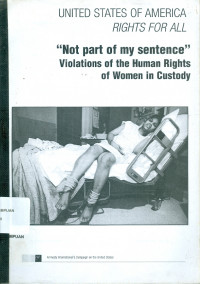
Text
"Not part of my sentence" :violations of the human rights of women in custody
There are around 138,000 women in jails and prisons in the USA, more than three times the number of women who were incarcerated in 1985.(4) Much of the increase is due to the so-called "war on drugs" conducted by federal and state government criminal justice authorities since the 1980s. About 40 percent of women in prison have been imprisoned for violating drug laws; only about 25 percent are in prison because they have committed a violent crime. One of the most striking characteristics of incarcerated women is that the proportion who are of racial and ethnic minority background greatly exceeds their representation in the general population. The rate of imprisonment of black women is more than eight times the rate of imprisonment of white women; the rate of imprisonment of Hispanic women is nearly four times the rate of imprisonment of white women. The "war on drugs" has had a disproportionate impact on racial and ethnic minority women. For example, in New York, 77 percent of Hispanic female prisoners and, 59 percent of black female prisoners are incarcerated for drug offences, compared with 34 percent of white female prisoners. For more than a decade, the number of women in prison and jails has increased at a faster rate than the increase in the rate at which men are being incarcerated but women still form only a small proportion – about eight percent – of the incarcerated population in the USA. Because women are such a minority, many authorities have not adapted their facilities and services to meet the particular needs of female inmates and have often treated them more poorly than male inmates. It is important to note that women's right to equality does not necessarily mean that they should receive the same treatment as men. For example, the right to adequate health services requires that services are tailored to take account of the different health care needs of women (such as pregnancy), and men. Prison authorities around the USA differ considerably in their responsiveness to developing programs specifically for women, as evidenced in the findings of a 1997 survey of 52 departments of corrections. Only 19 departments provided domestic violence programs developed specifically for women and only 9 departments offered programs for victims of sexual assault
Availability
| KP.1.00034 | KP.1 INT n | My Library | Available |
Detail Information
- Series Title
-
-
- Call Number
-
KP.1 INT n
- Publisher
- [Amerika] : Amnesty International., 1999
- Collation
-
103 hlm. : ilus. ; 30 cm.
- Language
-
English
- ISBN/ISSN
-
-
- Classification
-
KP.1
- Content Type
-
-
- Media Type
-
-
- Carrier Type
-
-
- Edition
-
-
- Subject(s)
- Specific Detail Info
-
-
- Statement of Responsibility
-
-
Other version/related
No other version available
File Attachment
Comments
You must be logged in to post a comment
 Computer Science, Information & General Works
Computer Science, Information & General Works  Philosophy & Psychology
Philosophy & Psychology  Religion
Religion  Social Sciences
Social Sciences  Language
Language  Pure Science
Pure Science  Applied Sciences
Applied Sciences  Art & Recreation
Art & Recreation  Literature
Literature  History & Geography
History & Geography